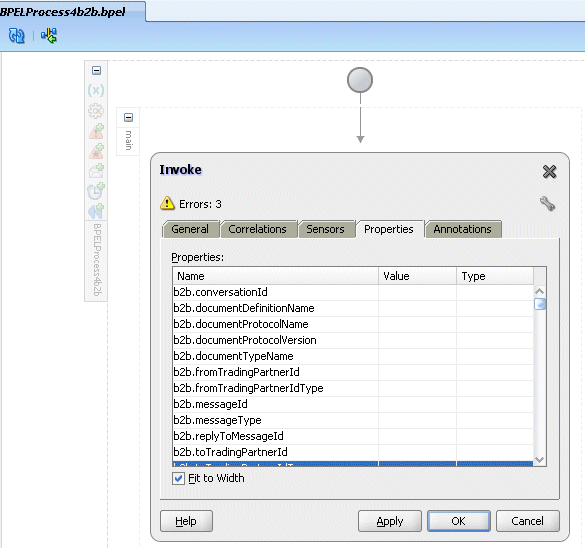E Back-End Applications Interface
This appendix lists the message properties supported by Oracle B2B.
The appendix contains the following topics:
E.1 Mapping B2B IP_MESSAGE_TYPE to SCA Normalized Message Properties
Table E-1 maps the B2B IP_MESSAGE_TYPE to SCA normalized message properties.
Table E-1 B2B IP_MESSAGE_TYPE to AS11 SCA Normalized Message Property Mapping
| AQ (IP_MESSAGE_TYPE) | SCA | JMS |
|---|---|---|
|
MSG_ID |
b2b.messageId |
MSG_ID |
|
INREPLYTO_MSG_ID |
b2b.replyToMessageId |
INREPLYTO_MSG_ID |
|
FROM_PARTY |
b2b.fromTradingPartnerId |
FROM_PARTY |
|
- |
b2b.fromTradingPartnerIdType |
- |
|
TO_PARTY_ID_VALUE |
b2b.toTradingPartnerId |
TO_PARTY |
|
TO-PART_ID_TYPE |
b2b.toTradingPartnerIdType |
- |
|
ACTION_NAME |
- |
ACTION_NAME |
|
DOCTYPE_NAME |
b2b.documentTypeName |
DOCTYPE_NAME |
|
DOCTYPE_REVISION |
b2b.documentProtocolVersion |
DOCTYPE_REVISION |
|
- |
b2b.documentProtocolName |
- |
|
- |
b2b.documentDefinitionName |
- |
|
MSG_TYPE |
b2b.messageType |
MSG_TYPE |
|
- |
b2b.conversationId |
- |
|
PAYLOAD |
body |
- |
|
ATTACHMENT |
attachments |
- |
E.2 Normalized Message Properties
Header manipulation and propagation are key business integration messaging requirements. Like other SOA components such as Oracle BPEL Process Manager, Oracle Mediator, and Oracle JCA, Oracle B2B relies on header support to solve integration needs. For example, you can preserve a file name from the source directory to the target directory by propagating it through message headers.
Normalized messages have two parts, properties and payload. Typically, properties are name-value pairs of scalar types. To fit the existing complex headers into properties, properties are flattened into scalar types.
Manipulating headers in design time is simplified by using predetermined complex properties. In B2B, you can manipulate headers with reserved key words. However, some properties are dynamically generated based on your input. These definitions are not predetermined and hence cannot be accounted for in the list of predetermined property definitions. You cannot design header manipulation of the dynamic properties before they are defined. To address this limitation, you must generate all the necessary services (composite entry points) and references. This restriction applies to services that are expected to generate dynamic properties. After dynamic properties are generated, they are stored for each composite, and can be manipulated in the composite editor.
Figure E-1 shows the Properties tab of an Invoke activity, part of a BPEL process that includes a B2B binding component. Enter values and specify the input or output type for B2B properties on this dialog.
Figure E-1 Invoke Activity Showing B2B Normalized Message Properties

Description of "Figure E-1 Invoke Activity Showing B2B Normalized Message Properties"
Table E-2 lists the predetermined properties of a normalized message for Oracle B2B.
Table E-2 Properties for Oracle B2B
| Property Name | Propagable (Yes/No) | Direction (Inbound /Outbound) | Data Type | Range of Valid Values | Description |
|---|---|---|---|---|---|
b2b.conversationId |
No |
Both |
String |
- |
The ID used to relate the message to the message response |
b2b.documentDefinitionName |
No |
Both |
String |
- |
The document definition, for example, 850_def for an EDI X2 document |
b2b.documentProtocolName |
No |
Both |
String |
- |
The document protocol, for example, X12 for an EDI X12 document |
b2b.documentProtocolVersion |
No |
Both |
String |
- |
The document version, for example, 4010 for an EDI X12 document |
b2b.documentTypeName |
No |
Both |
String |
- |
The document type, for example, 850 for an EDI X12 document |
b2b.fromTradingPartnerId |
No |
Both |
String |
- |
The trading partner identifier of the sender, for example, the name, such as Acme, or a DUNS number |
b2b.fromTradingPartnerIdType |
No |
Both |
String |
- |
The trading partner identifier type for the sender, for example, Name or DUNS |
b2b.messageId |
No |
Both |
String |
- |
A unique message ID, not directly related to ECID. (ECID information is stored in the B2B AppMessage table.) |
b2b.messageType |
No |
Both |
String |
- |
Message type values are:
|
b2b.replyToMessageId |
No |
Both |
String |
- |
The message ID to which the sending message is replying |
b2b.toTradingPartnerId |
No |
Both |
String |
- |
The trading partner identifier of the receiver, for example, the name, such as Acme, or a DUNS number. |
b2b.toTradingPartnerIdType |
No |
Both |
String |
- |
The trading partner identifier type for the receiver, for example, Name or DUNS. If no value is found, the Name type is assumed. |